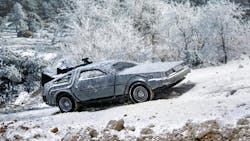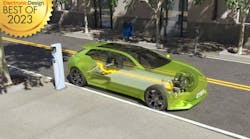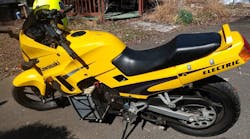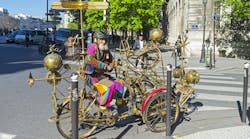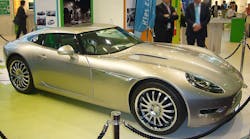So...You Want to Convert Your Gas/Diesel ICE Vehicle to Electric?
What you’ll learn:
- It’s possible to convert an ICE car or truck to use components from salvaged Tesla, Nissan, and Chevy electric vehicles.
- The complete transplant of wiring and components from a crashed EV to a classic car is possible.
- Commercial controllers available on the market are essentially plug and play for an EV conversion.
- Open-source controllers are available to enable use of salvaged DC-DC converters, AC chargers, traction motors, and battery-management systems.
- The DIY EV conversion community has cracked high-speed CCS charging protocols, including Tesla Superchargers, enabling ICE conversions to use public chargers.
- How to get started in converting a gas/diesel car or truck to electric propulsion.
Got a classic car
That's got a clapped out driveline?
Make it electric
The availability of almost full torque from a stop is what differentiates an electric vehicle from its ICE counterpart. Since many of us drive on the streets most of the time, such low-end torque produces a force that then transforms into a grin on your face. Once you’ve driven an electric vehicle, it’s really tough to go back. And it’s not a whole lot more complicated to hotrod a classic car as electric if you know the recipe and where to look for resources.
With that, let me introduce what some of my engineering friends, colleagues, and acquaintances are up to in the after-hours EV conversion space. Many of them are breathing new life into the cars that were dear to them earlier in their lives.
Lightening Bolts and Back to the Future
So, what happens when a Chevy Bolt EV gets totaled? If you’re Seattle-area's Bill Carlson, a lead software engineer for Microsoft where he develops some game called Minecraft, you buy a rear-ended Bolt at a salvage auction and then meticulously disassemble it. You label and document each and every wire with the goal of transplanting everything, including the instrument cluster and center display, into a de-ICEd DeLorean.
Bill actually succeeded with pulling off the crazy transplant, demonstrating a test drive a few months ago on his YouTube channel, where he’s documented his build, and recently did a complete rework of the wiring to where it’s no longer a prototyped ratsnest. Bill’s deBoltean (he calls it ‘Project Lightning’), amazingly, still works and will likely be the first DIY EV conversion with Apple CarPlay. Note that with 1-in. smaller diameter tires, the 92-mph speed-governed Bolt EV system would result in a speed barrier for the DeLorean of 88 mph. Just sayin’...
Tesla Goes International
Also in the Seattle area is Mark, who’s an EE at a stealth startup doing AI Computer Systems Architecture. Mark is working on converting the 1952 International pickup, which he got from his farmer-grandfather and that he drove in high school, to electric propulsion. Wanting a bit more than what the stock truck frame and suspension could offer for handling performance, Mark commissioned renowned chassis-builder Art Morrison whose Seattle-area shop mandrel-bent a full-custom tube chassis for the truck.
Now that the chassis is done, and with a change to using a Tesla drive unit instead of the Ford, Mark just bought a “donor” Tesla Model 3 at a salvage auction and my eight-year-old engineering apprentice and I will be driving up in my Bolt EV for a “battery dropping party”...the stuff I do to guilt people into writing contributed articles in future for us here, LOL. Mark plans to use a T2C from EV-Controls to pull everything together control-wise—it handles CANbus communications with the drive units and the battery-management system.
Heavy Metal Meets Plastic
A similar propulsion and control approach is being used by “428RC,” a Mechanical Engineer in Florida, who’s converting a 1962 Corvette on a tubular steel racing chassis that features a C5 suspension system. He’s planning a Tesla-based all-wheel drive and on using Chrysler Pacifica batteries, though. One interesting approach in fit-up was his use of 3D printing to create mock, easy-to-handle, full-size, front and rear Tesla Model 3 plastic drive units.
Honda Owner Can’t Leaf It Alone
SF Bay area-based Viet, a software engineer, picked up a smashed Nissan Leaf at an insurance auction, cannibalized it for all the parts he thought he might need, and then de-ICE'd his Honda CRX, methodically installing the Leaf “stack” (a factory assembly of motor, gearbox, inverter, and charger) into the engine bay. He then mechanically reconfigured the Leaf’s battery cells and shoehorned them into the trunk area of the car.
His choice to coordinate all of the Leaf pieces was a solution from Resolve-EV, though Leaf-integration solutions are also available from Thunderstruck-EV and the open-sourced “Zombieverter.” Viet got the car to be California road legal, drove it for about six months, and then tore a good part of his build back down in a new build...a front and rear Leaf stack in the CRX for AWD. He has a most-excellent build thread of it all, here.
de-ICE’d ‘berg Ahead
Electronic Design’s resident tree-hugging hippie, Lee Goldberg, acquired an already-converted motorcycle with a compromised Leaf battery system that needed to be reworked. An introduction to his project series is here. Still a work in progress, Lee promises to get back to it soon and write about his efforts on Electronic Design.
Forking Around
Electronic Design’s now-retired analog editor, Paul Rako, acquired an already-converted Honda Civic, but reworked its battery system to a low-CG arrangement of deep-cycle, lead-acid Trojan batteries—the best option we had for mobility energy storage back then. He replaced the electric motor with a 9-in., DC forklift-derived-design brushed electric motor, fabricating an adapter plate for it to couple to the existing Honda tranny. Some details on the car and its “old school” build can be found on Paul’s website, here.
“Duncan,” a retired Mechanical Engineer living in New Zealand, built a Locost-7 and equipped his EV using “old school” methods, using a 48-V brushed forklift motor for propulsion and a Chevy Volt battery pack. Duncan enjoys racing the car and its winning performance comes from “overvolting” the forklift motor to where it had signs of internal arcing at its 340-V battery voltage while pushing 1200 A through it. His build thread, starting a decade and a half ago, is here. Duncan continues to explore the limits of powering the car, increasing voltage and current.
EV Conversions as Engineering Testbeds
The open-source movement has also been embraced by the DIY electric-car enthusiasts with a hotbed of activity being spearheaded by two European electrical engineers on the Open Inverter Forum.
Johannes, from Germany, and Damien, from Ireland, started out as EV hobbyists, but both have quit their day jobs to make the world a better place. They have produced a number of controllers for EV conversion that enable the use of salvage vehicle components for propulsion and charging.
Both engineers have performed a number of ICE conversions as engineering-development testbeds, featured in detail on Damien’s and Johannes’ YouTube channels. Johannes recently completed a brave road trip from Germany to Sweden and back, charging his converted VW Tourag with high-speed public chargers using a newly developed, open-source, CCS charge controller during the trek. Don’t expect polished, adrenaline-rush, video production from these guys as these are more in the vein of engineering documentation and project status updates than a salty National Geographic documentary.
Damien’s EVBMW online store offers a number of open-source traction control solutions for various EV drive units, as well as boards to control such devices as Tesla on-board HV battery chargers. The development of many of the solutions involved meticulous CANbus sniffing and emulation, one aspect of reuse that OEMs unnecessarily hold close to their vest.
Right to repair is one thing, but reusing salvage components to convert ICE vehicles to electric propulsion is the ultimate use of resources and avoids a serious e-waste problem that our throwaway society is generating.
Plug and Chug
One major coup that Johannes has recently released, among many control boards in the OIF web store, is his volunteer team’s crack of the protocols used at public high-speed chargers, including European Tesla Superchargers (which use CCS protocols, unlike North America). The 380 Euro CCS controller fully supports CCS1 (North America) and CCS2 (Europe), and it’s been tested on numerous charger brands and features:
- A configurable CAN interface for BMS and vehicle communication
- Two Contactor drivers for charge port contactors
- A lock motor driver with optional feedback for locking the connector to the charge inlet
- Three LED drivers for red, green, and blue
- Three temperature sensor inputs to measure charge inlet pin temperatures
- A pushbutton input
- An analog input for a separately measured charge port inlet voltage (optional)
Besides running DC fast-charge sessions, the controller can also handle AC charging sessions and forwards CP and PP current limits via CAN to a separate on-board charger.
The open-source hardware design for the CCS controller, which uses an STMicroelectronics STM32F103RE and a Qualcomm QCA7005 homeplug modem, can be found here, with the open-source software repository being here. The populated CCS Controller circuit board is available for pre-order here.
Where to Start
The first thing everyone seems to ask for is a book on how to convert an ICE car to electric. While books can be found on Amazon, eBay, etc., they’re primarily “old school,” low-voltage, forklift-derived-motor-based conversions that are now considered obsolete. With the recent glut of EVs, the availability of low-cost components from cars made by Nissan, Tesla, Prius, and others usually means 400- to 800-V battery systems and high-efficiency three-phase induction, or permanent-magnet, motors.
A great place to start is to study the build threads in online forums that include DIY Electric Car and the Open Inverter Forum. Johannes recently released a conversion book that covers modern conversion techniques, available here for purchase as a downloadable PDF.
Who knows, your first EV-conversion project might help you end up where one of the members of the DIY Electric Forum has...
Choosing a battery for your Hypercar build.
For those of you itching to get back into circuit design stuff, I just received the manuscript from Sariel to round out the Analog Computing series, so look for that one in the coming week or so, after I get it edited and fed into our publishing pipeline. I also plan to pull it all together in one place by producing an Analog Computing TechXchange.
All for now,
-AndyT
Andy's Nonlinearities blog arrives the first and third Monday of every month. To make sure you don't miss the latest edition, subscribe to our Electronic Design Today newsletter.
About the Author
Andy Turudic
Technology Editor, Electronic Design
Andy Turudic is a Technology Editor for Electronic Design Magazine, primarily covering Analog and Mixed-Signal circuits and devices. He holds a Bachelor's in EE from the University of Windsor (Ontario Canada) and has been involved in electronics, semiconductors, and gearhead stuff, for a bit over a half century.
"AndyT" brings his multidisciplinary engineering experience from companies that include National Semiconductor (now Texas Instruments), Altera (Intel), Agere, Zarlink, TriQuint,(now Qorvo), SW Bell (managing a research team at Bellcore, Bell Labs and Rockwell Science Center), Bell-Northern Research, and Northern Telecom and brings publisher employment experience as a paperboy for The Oshawa Times.
After hours, when he's not working on the latest invention to add to his portfolio of 16 issued US patents, he's lending advice and experience to the electric vehicle conversion community from his mountain lair in the Pacific Northwet[sic].
AndyT's engineering blog, "Nonlinearities," publishes the 1st and 3rd monday of each month. Andy's OpEd may appear at other times, with fair warning given by the Vu meter pic.
